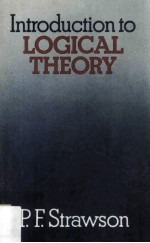

Introduction to Logical TheoryPDF电子书下载
- 电子书积分:11 积分如何计算积分?
- 作 者:
- 出 版 社:Methuen & Co Ltd.
- 出版年份:1952
- ISBN:0416682200
- 页数:266 页
Chapter 1.LOGICAL APPRAISAL 1
1.Logical appraisal;and other kinds 1
Ⅰ.INCONSISTENCY 2
2.Words of logical appraisal have connected meanings 2
3.Contradicting oneself 2
4.Statements,not sentences,are inconsistent with one another 3
5.Incompatible predicates 5
6.Negation 7
7.Definition 9
8.Linguistic rules and logical relations 9
Ⅱ.REASONING 12
9.Arguing,proving,inferring:validity 12
10.Not all'valid steps'are steps in reasoning 13
Ⅲ.THE LOGICIAN'S SECOND-ORDER VOCABULARY 15
11.Use to be made of logician's higher-order words 15
12.Contraries and contradictories 16
13.Entailment and inconsistency 19
14.Logically necessary statements;entailment and necessity 21
15.A problem 24
16.Logical equivalence;subcontrariety;necessary and sufficient conditions 24
Chapter 2.FORMAL LOGIC 26
1.The formal logician is not a list-maker 26
Ⅰ.GENERALITY.THE USE OF FORMULAE 26
2.The generality of logicians'entailment-statements 26
3.The use of formulae 27
4.Entailment between sentences and between formulae 31
5.The range of values of a variable 32
6.'Inconsistent','logically necessary'applied to formulae 33
7.Misinterpretations of'?' 35
8.The point of using'?' 39
Ⅱ.FORM 40
9.The limitations implied by'formal'.Rules for representative patterns 40
10.Formal analogies and verbal frameworks 43
11.A formal analogy without a framework:transitivity 45
12.Logical constants 47
13.Logical forms of statements explained in terms of formal analogies 49
14.Logical form and logicians'formulae 52
15.Mistakes about logical form 53
Ⅲ.SYSTEM 56
16.The logical ideal of system,and its effects 56
17.Methods of systematization 58
18.Abstract systems and their interpretation 61
Chapter 3.TRUTH-FUNCTIONS 64
Ⅰ.TRUTH TABLES 64
1.Formation-rules 64
2.The meanings of the symbols of the system 65
3.Use of the tables in determining truth-conditions 70
4.Use of the tables for establishing logical relations and testing formulae 71
5.Some laws of the system 74
Ⅱ.TRUTH-FUNCTIONAL CONSTANTS AND ORDINARY WORDS 78
6.The customary identifications 78
7.'~'and'not' 79
8.'·'and'and' 79
9.'?'and'if' 82
10.'?'and'if and only if' 90
11.'v'and'or' 90
Ⅲ.TRUTH-FUNCTIONAL CONSTANTS AND LOGICAL RELATIONS.THE DEDUCTIVE SYSTEM OF TRUTH-FUNCTIONS 93
12.'?'and'entails' 93
13.The stroke-function 96
14.The deductive system of truth-functions 97
15.Examples of derivations 100
Chapter 4.CLASSES:AN ALTERNATIVE INTERPRETATION OF THE TARULAR SYSTEM 102
1.The system as an abstract exercise 102
2.An alternative interpretation.Class-expressions and class-constants 103
3.Class-statement formulae 107
4.The use of the tables to establish logical rules about class formulae 111
5.Parallels with ordinary speech.Re-expression of rules as entailments between class-membership formulae 119
6.Limitations of this use of the mechanism of the tables 120
Chapter 5.PREDICATIVE FORMULAE AND QUANTIFIERS 125
Ⅰ.THE ELEMENTS OF THE PREDICATIVE SYSTEM 125
1.Relations between the class and truth-functional systems 125
2.The paraphrasing of class-statement formulae in a new notation 129
3.Proofs in the new notation 134
4.Multiple quantification and relational predicates 138
Ⅱ.THE PREDICATIVE SYSTEM AND ORDINARY SPEECH:PRELIMINARIES 143
5.The distinction between individual and predicative expressions:referring and describing 143
6.Claims made on behalf of the symbolism of the system 146
7.'(?)'and tenses 150
Chapter 6.SUBJECTS,PREDICATES,AND EXISTENCE 152
Ⅰ.THE TRADITIONAL SYSTEM OF CATEGORICAL PROPOSITIONS 152
1.Formulae 152
2.Laws 155
3.Systematization 160
Ⅱ.THE ORTHODOX CRITICISMS OF THE SYSTEM 163
4.The dilemma of existence 163
5.The detail of the dilemma 165
Ⅲ.SUBJECTS AND PREDICATES 170
6.A formalistic solution 170
7.The realistic solution:presupposition and entailment 173
8.Class-membership and class-inclusion.Subject-predicate statements 179
9.The relevance of the analysis of general statements as conjunctions of singular statements 183
10.Singular statements beginning with'the'and'a' 184
11."'Exists'is not a predicate" 190
12.Limitations of the traditional system 192
Chapter 7.GENERAL STATEMENTS AND RELATIONS 195
Ⅰ.GENERAL STATEMENTS 195
1.The truth-conditions of general subject-predicate statements 195
2.Different kinds of general sentences 195
3.Law-statements 198
4.The impossibility of a neat classification of general sentences 201
Ⅱ.RELATIONS 202
5.Transitivity 202
6.Symmetry 204
7.Relations and their converses 204
8.The strained use of'relation' 205
9.Attempts to'reduce'relational inferences 207
10.The logical forms of arguments 209
Chapter 8.TWO KINDS OF LOGIC 211
Ⅰ.FORMAL LOGIC:APPLICATIONS AND LIMITATIONS 211
1.Entailment-rules and referring rules 211
2.Logically ideal sentences 214
3.The use of modern logical symbolism in systems of necessary truth and natural law 217
Ⅱ.TYPE-DIFFERENCES AND FORMATION-RULES 224
4.Formation-rules and rules of grammar 224
5.Non-grammatical type-restrictions 226
6.The metaphysical belief in basic types 227
Ⅲ.THE LOGIC OF LANGUAGE 230
7.The fluidity of language 230
8.The logic of ordinary speech 231
Chapter 9.INDUCTIVE REASONING AND PROBABILITY 233
Ⅰ.SUPPORT AND PROBABILITY 233
1.Non-deductive reasoning 233
2.Degrees of support:the use of'probable',etc 237
3.Support and relative frequencies 241
4.Support and numerical chances 242
5.Degrees of support for generalizations 244
6.No precise rules for the assessment of evidence 247
Ⅱ.THE'JUSTIFICATION'OF INDUCTION 248
7.The doubt and its source 248
8.The desire for a supreme premise of inductions 251
9.The attempt to find a mathematical justification 252
10.The senselessness of the demand 256
11.Any successful method of finding things out must be inductively supported 258
12.The belief that the soundness of induction requires a'presupposition'may rest upon the confused conflation of two questions 260
INDEX 264
- 《功能化介孔材料捕集CO2研究》周凌云,李涵,梁方方著 2019
- 《Ni基催化剂催化CO甲烷化性能研究及优化》智翠梅著 2019
- 《Premiere Pro CS5非线性编辑 第2版》赵英杰主编;王庚,路光副主编 2013
- 《优雅黑白灰 摄影技术流 最超值的摄影技法书》(英)大卫·泰勒 2012
- 《中国“80后”大学教师胜任力评价研究=RESEARCH ON THE EVALUATION OF CHINA'S POST 80s GENERATION UNIVERSITY TEACHERS' CO》黄艳著 2013
- 《你从未发现的Photoshop+ Illustrator+ InDesign CS6创意课》英国未来出版著;王慧玲译 2013
- 《地下咸水层CO2封存实践》(英)AndyChadwick等编;曾荣树,刘大安,陈代钊等译 2013
- 《超临界条件下环状碳酸酯的催化合成》吕小兵著 2013
- 《文书写作》周屏,李天相主编;熊国秀,蔡建中,姚国祥等副主编 1991
- 《瓦斯爆炸反应动力学特性及其抑制机理》梁运涛著 2013
